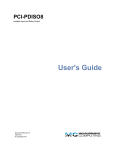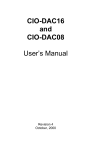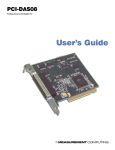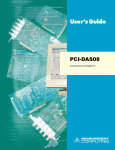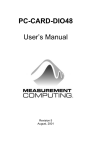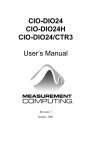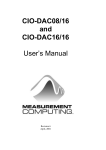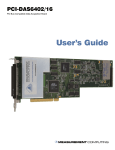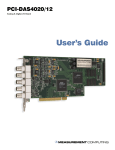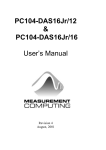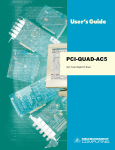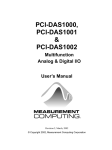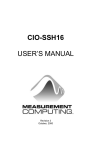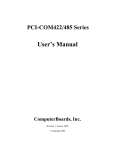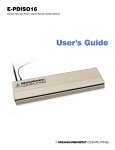Download User`s Guide
Transcript
PCI-PDISO16 Digital Input Board User’s Guide Document Revision 4, October, 2003 © Copyright 2003, Measurement Computing Corporation Lifetime warranty Every hardware product manufactured by Measurement Computing Corp. is warranted against defects in materials or workmanship for the life of the product, to the original purchaser. Any products found to be defective will be repaired or replaced promptly. 30 Day Money Back Guarantee Any Measurement Computing Corp. product may be returned within 30 days of purchase for a full refund of the price paid for the product being returned. If you are not satisfied, or chose the wrong product by mistake, you do not have to keep it. Please call for an RMA number first. No credits or returns accepted without a copy of the original invoice. Some software products are subject to a repackaging fee. These warranties are in lieu of all other warranties, expressed or implied, including any implied warranty of merchantability or fitness for a particular application. The remedies provided herein are the buyer’s sole and exclusive remedies. Neither Measurement Computing Corp., nor its employees shall be liable for any direct or indirect, special, incidental or consequential damage arising from the use of its products, even if Measurement Computing Corp. has been notified in advance of the possibility of such damages. MEGA-FIFO, the CIO prefix to data acquisition board model numbers, the PCM prefix to data acquisition board model numbers, PCM-DAS08, PCM-D24C3, PCM-DAC02, PCM-COM422, PCM-COM485, PCMDMM, PCM-DAS16D/12, PCM-DAS16S/12, PCM-DAS16D/16, PCM-DAS16S/16, PCI-DAS6402/16, Universal Library, InstaCal, Harsh Environment Warranty and Measurement Computing Corporation are either trademarks or registered trademarks of Measurement Computing Corporation. IBM, PC, and PC/AT are trademarks of International Business Machines Corp. Windows is a trademark of Microsoft Corp. All other trademarks are the property of their respective owners. Information furnished by Measurement Computing Corp. is believed to be accurate and reliable. However, no responsibility is assumed by Measurement Computing Corporation neither for its use; nor for any infringements of patents or other rights of third parties, which may result from its use. No license is granted by implication or otherwise under any patent or copyrights of Measurement Computing Corporation. All rights reserved. No part of this publication may be reproduced, stored in a retrieval system, or transmitted, in any form by any means, electronic, mechanical, by photocopying, recording or otherwise without the prior written permission of Measurement Computing Corporation. Notice Measurement Computing Corporation does not authorize any Measurement Computing Corporation product for use in life support systems and/or devices without the written approval of the CEO of Measurement Computing Corporation. Life support devices/systems are devices or systems which, a) are intended for surgical implantation into the body, or b) support or sustain life and whose failure to perform can be reasonably expected to result in injury. Measurement Computing Corp. products are not designed with the components required, and are not subject to the testing required to ensure a level of reliability suitable for the treatment and diagnosis of people. HM PCI-PDISO16.doc ii Lifetime Harsh Environment Warranty™ Any product manufactured by Measurement Computing Corp. that is damaged (even due to misuse) may be replaced for only 50% of the current list price. I/O boards face some tough operating conditionssome more severe than the boards are designed to withstand. When a board becomes damaged, just return the unit with an order for its replacement at only 50% of the current list price. We don’t need to profit from your misfortune. By the way, we honor this warranty for any manufacturer’s board that we have a replacement for. iii Table of Contents Preface About this User's Guide .................................................................................... vii What you will learn from this user's guide................................................................... vii Conventions in this user's guide ................................................................................... vii Where to find more information.................................................................................. viii Chapter 1 Introducing the PCI-PDISO16 .......................................................................... 1-1 Software features – InstaCal and Universal Library ............................................ 1-1 Chapter 2 Installing the Board .......................................................................................... 2-1 What is included with your board ............................................................................... 2-1 Standard shipment .................................................................................................................. 2-1 Optional components.............................................................................................................. 2-2 Unpacking the board ................................................................................................... 2-4 Installing the software ................................................................................................. 2-4 Installing the hardware................................................................................................ 2-5 Connecting the board for I/O operations..................................................................... 2-6 Connectors, cables – main I/O connector ............................................................................... 2-6 Pinout – I/O connector ........................................................................................................... 2-7 PCI-PDISO8 compatibility..................................................................................................... 2-9 Field wiring and signal termination accessories ................................................................... 2-10 Chapter 3 Programming and Developing Applications .................................................. 3-1 Programming languages.............................................................................................. 3-1 Packaged applications programs ................................................................................. 3-1 Register-level programming........................................................................................ 3-2 Chapter 4 Functional Description ..................................................................................... 4-1 Basic architecture ........................................................................................................ 4-1 Isolated inputs ............................................................................................................. 4-2 Extending the input range....................................................................................................... 4-2 Form C relay outputs................................................................................................... 4-3 Chapter 5 Specifications.................................................................................................... 5-1 Relay Specifications.................................................................................................... 5-1 Isolated Inputs ............................................................................................................. 5-1 v PCI-PDISO16 User's Guide Power Consumption.................................................................................................... 5-1 Environmental............................................................................................................. 5-2 Main Connector and Pin out ....................................................................................... 5-2 vi Preface About this User's Guide What you will learn from this user's guide This user's guide explains how to install, configure, and use the PCI-PDISO16 so that you get the most out of its digital input features. This user's guide also refers you to related documents available on our web site, and to technical support resources that can also help you get the most out of these boards. Conventions in this user's guide The following conventions are used in this manual to convey special information. For more information on … Text presented in a box signifies additional information and helpful hints related to the subject matter you are reading. Caution! Shaded caution statements present information to help you avoid injuring yourself and others, damaging your hardware, or losing your data. <#:#> Angle brackets that enclose numbers separated by a colon signify a range of numbers, such those assigned to registers, bit settings, etc. bold text Bold text is used for the names of objects on the screen, such as buttons, text boxes, and check boxes. For example: 1. Insert the disk or CD and click the OK button. italic text Italic text is used for the names of manuals and help topic titles, and to emphasize a word or phrase. For example: The InstaCal installation procedure is explained in the Software Installation Manual. Never touch the exposed pins or circuit connections on the board. vii PCI-PDISO16 User's Guide About this User's Guide Where to find more information The following electronic documents provide information that can help you get the most out of the PCI-PDISO16 board. MCC's Guide to Signal Connections is available on our web site at www.mccdaq.com/signals/signals.pdf. MCC's Register Map for the PCI-PDISO16 is available on our web site at www.mccdaq.com/registermaps/RegMapPCI-PDISO16.pdf. MCC's Specifications: PCI-PDISO16 (the PDF version of Chapter 5 in this guide) is available on our web site at www.mccadq.com/pdfs/PCI-PDISO16.pdf. MCC's Universal Library User's Guide is available on our web site at www.mccdaq.com/PDFmanuals/sm-ul-user-guide.pdf. MCC's Universal Library Function Reference is available on our web site at www.mccdaq.com/PDFmanuals/sm-ul-functions.pdf This user's manual is also available on our web site at www.mccdaq.com/PDFmanuals/PCI-PDISO16.pdf. viii Chapter 1 Introducing the PCI-PDISO16 This manual explains how to install and use the PCI-PDISO16 board. The PCI-PDISO16 is a 16-channel isolated-input and relay output digital interface board for PCI-compatible computers. The board is designed for applications where high voltages need to be sensed or controlled. The PCI-PDISO16 board provides 16 digital inputs and 16 Form C relay outputs. The 16 individual, optically isolated (500V) inputs can be read back as two 8-bit bytes. The inputs are not polarity sensitive, and can be driven by either AC (50 to 1000 Hz) or DC at levels up to 28 Volts. Each input channel has a software-enabled low-pass filter with a time constant of 5 ms (200 Hz). The 16 outputs are dry contact, Form-C electromechanical relays. The relays are controlled by writing to two eight-bit ports. The state of the relays can be determined by reading the same two ports. The PCI-PDISO16 board is completely plug-and-play, with no switches or jumpers to set. Software features – InstaCal and Universal Library PCI-PDISO16 boards ship with the InstaCal software configuration utility package. InstaCal is a complete installation, calibration, and test program for data acquisition and control boards. Complete with extensive error checking, InstaCal guides you through the installation and setup of your data acquisition board, and creates the board configuration file for use by your program or application software package. The procedure for installing InstaCal is explained in the Software Installation Manual (available on our web site at www.mccdaq.com/PDFmanuals/sm-installation.pdf). The optional Universal Library™ fully supports the PCI-PDISO16 boards. The Universal Library is a complete set of I/O libraries and drivers for all MCC boards and for all Windows-based languages. When using the Universal Library, you can switch boards or even programming languages, and the syntax remains constant. 1-1 Chapter 2 Installing the Board This section contains instructions on the installation and configuration of your PCIPDISO16 board, and includes cabling and accessory equipment. What is included with your board As you unpack your board shipment, verify that the following components are included. Standard shipment The following items should be included with your shipment: PCI-PDISO16 board (shown with protective cover removed – it is recommended that this cover be left in place during use) InstaCal installation CD. If you ordered the optional Universal Library, use that CD to install both InstaCal and the Universal Library. 2-1 PCI-PDISO16 User's Guide Installing the Board MCC's Software Installation Manual Optional components If you ordered any of the following products with your PCI-PDISO16 board, they should be included with your shipment. Universal Library Universal Library™ Data Acquisition and Control Programming Tools (InstaCal installation package is included on the CD) Universal Library User's Guide and Universal Library Function Reference. 2-2 PCI-PDISO16 User's Guide Installing the Board Cables C50FF-x C50-37F-x For more information on these MCC cables, refer to the "Connecting the board for I/O operations" section on page 2-10. Accessories MCC provides signal termination products for use with the PCI-PDISO16. Refer to the "Field wiring and signal termination accessories" section for a complete list of compatible accessory products. If any items are missing or damaged, contact Measurement Computing Corp. by phone, fax, or e-mail: Phone: 508-946-5100 and follow the instructions for reaching Tech Support. Fax: 508-946-9500 to the attention of Tech Support Email: [email protected] 2-3 PCI-PDISO16 User's Guide Installing the Board Unpacking the board Each PCI-PDISO16 board is shipped in an antistatic container to prevent damage by an electrostatic discharge. To avoid such damage, perform the following procedure when unpacking and handling your board: 1. Before opening the antistatic container, ground yourself with a wrist-grounding strap or by holding onto a grounded object (such as the computer chassis). 2. Touch the antistatic container to the computer chassis before removing the board from the container. 3. Remove the board from the container. Never touch the exposed pins or circuit connections on the board. Installing the software We recommended that you install the InstaCal software included with your board before you install the hardware. If you ordered the Universal Library software, install that software instead. InstaCal is installed at the same time as the Universal Library. Installing the software first ensures that the information required for proper board detection is installed and available at boot up. The procedure for installing InstaCal is explained in the Software Installation Manual included with your board (and also available on our web site at www.mccdaq.com/PDFmanuals/sm-installation.pdf). If you ordered the Universal Library… If you ordered the optional Universal Library, use that CD to install both InstaCal and the Universal Library. 2-4 PCI-PDISO16 User's Guide Installing the Board Installing the hardware The PCI-PDISO16 board is completely plug-and-play, with no switches or jumpers to set. Configuration is controlled by your system's BIOS. To install your board, follow the steps below: 1. Turn your computer off, open it up, and insert your board into an available PCI slot. 2. Close your computer and turn it on. If you are using an operating system with support for plug-and-play (play (such as Windows 95 or Windows 2000), a dialog box displays as the system loads, indicating that new hardware has been detected. If the information file for this board is not already loaded onto your PC, you are prompted for the disk containing this file. The InstaCal software supplied with your board contains this file. If required, insert the disk or CD and click OK. 3. To test your installation and configure your board, run the InstaCal utility you installed in the previous section. Refer to the Software Installation Manual that came with your board (www.mccdaq.com/PDFmanuals/sm-installation.pdf) for information on how to initially set up and load InstaCal. Configuring the hardware All hardware configuration options on the PCI-PDISO16 are software controlled. You can select some of the configuration options using InstaCal. Once configured, any program that uses the Universal Library will initialize the hardware according to these selections. 2-5 PCI-PDISO16 User's Guide Installing the Board Connecting the board for I/O operations Connectors, cables – main I/O connector Table 2-1 lists the board connectors, applicable cables and compatible accessory boards. Table 2-1. Board Connectors, Cables, Accessory Equipment Connector type 50-pin IDC type C50FF-x: 50-pin IDC female to female cable. x = length in feet. Compatible cables C50-37F-x: 50-pin IDC to 37-pin female D connector (adaptor cable for connecting to a PCI-PDISO8 compatible interface). x = length in feet. CIO-MINI50 Compatible accessory products CIO-TERM100 (using C50FF-x cable) SCB-50 CIO-MINI37 Compatible accessory products CIO-TERMINAL (using C50-37F-x cable) SCB-37 The PCI-PDISO16 board has two 50-pin connectors for signal I/O connections, identified here as Port A and Port B. Port A is located adjacent to the main I/O connector bracket at the left side of the board, and is labeled P2. Port B is located towards the middle-right side of the board, and is labeled P3. Figure 2-1 shows the location of the board’s port connectors and relays. Port A Relays 0-7 Port A Connector (P2) Port B Relays 0-7 Port B Connector (P3) Figure 2-1. Port A and Port B locations 2-6 PCI-PDISO16 User's Guide Installing the Board The pinout for the Port A connector is defined in Table 2-2. The pinout for the Port B connector is defined in Table 2-3. Pinout – I/O connector Table 2-2. Port A connector pinout Signal Name NC NC NC NC NC RELAY 6 (NC) RELAY 7 (NC) RELAY 0 (C) RELAY 1 (NO) RELAY 1 (NC) RELAY 2 (C) RELAY 3 (NO) RELAY 3 (NC) RELAY 4 (C) RELAY 5 (NO) RELAY 6 (NO) RELAY 7 (NO) INPUT 0 INPUT 1 INPUT 2 INPUT 3 INPUT 4 INPUT 5 INPUT 6 INPUT 7 PCI slot Pin 50 48 46 44 42 40 38 36 34 32 30 28 26 24 22 20 18 16 14 12 10 8 6 4 2 ↓ 2-7 •• •• •• •• •• •• •• •• •• •• •• •• •• •• •• •• •• •• •• •• •• •• •• •• •• Pin Signal Name 49 47 45 43 41 39 37 35 33 31 29 27 25 23 21 19 17 15 13 11 9 7 5 3 1 NC NC NC NC NC RELAY 5 (NC) RELAY 0 (NO) RELAY 0 (NC) RELAY 1 (C) RELAY 2 (NO) RELAY 2 (NC) RELAY 3 (C) RELAY 4 (NO) RELAY 4 (NC) RELAY 5 (C) RELAY 6 (C) RELAY 7 (C) INPUT 0 INPUT 1 INPUT 2 INPUT 3 INPUT 4 INPUT 5 INPUT 6 INPUT 7 PCI-PDISO16 User's Guide Installing the Board Signal Name Table 2-3. Port B connector pinout NC NC NC NC NC RELAY 6 (NC) RELAY 7 (NC) RELAY 0 (C) RELAY 1 (NO) RELAY 1 (NC) RELAY 2 (C) RELAY 3 (NO) RELAY 3 (NC) RELAY 4 (C) RELAY 5 (NO) RELAY 6 (NO) RELAY 7 (NO) INPUT 0 INPUT 1 INPUT 2 INPUT 3 INPUT 4 INPUT 5 INPUT 6 INPUT 7 PCI slot Pin 50 48 46 44 42 40 38 36 34 32 30 28 26 24 22 20 18 16 14 12 10 8 6 4 2 •• •• •• •• •• •• •• •• •• •• •• •• •• •• •• •• •• •• •• •• •• •• •• •• •• Pin Signal Name 49 47 45 43 41 39 37 35 33 31 29 27 25 23 21 19 17 15 13 11 9 7 5 3 1 NC NC NC NC NC RELAY 5 (NC) RELAY 0 (NO) RELAY 0 (NC) RELAY 1 (C) RELAY 2 (NO) RELAY 2 (NC) RELAY 3 (C) RELAY 4 (NO) RELAY 4 (NC) RELAY 5 (C) RELAY 6 (C) RELAY 7 (C) INPUT 0 INPUT 1 INPUT 2 INPUT 3 INPUT 4 INPUT 5 INPUT 6 INPUT 7 ↓ Caution! High voltages are present on the PCI-PDISO16 board when you connect high voltage inputs or outputs to the board’s connector. Use extreme caution! Never handle the PCI-PDISO16 board when signals are connected to the board through the connector. Do not remove the protective plates on the PCI-PDISO16 board. 2 1 50 49 The red stripe identifies pin # 1 50-pin Female IDC Connector 2 1 50 49 50-pin Female IDC connector Figure 2-2. C50FF-x cable Details on this cable are available on our web site at www.mccdaq.com/cbicatalog/cbiproduct.asp?dept_id=104&pf_id=136. 2-8 PCI-PDISO16 User's Guide Installing the Board PCI-PDISO8 compatibility For connections to a PCI-PDISO8 compatible interface, use a C50-37F-x adaptor cable. This cable converts the PCI-PDISO16 board’s connector to a PDIS08-compatible D connector. Two adaptor cables are required if more than eight relays are used. Pin assignments for the C50-37F-x cable are shown in Figure 2-3. Details on this cable are available on our web site at www.mccdaq.com/cbicatalog/cbiproduct.asp?dept_id=104&pf_id=116. RELAY 0 RELAY 1 RELAY 1 RELAY 2 RELAY 3 RELAY 3 RELAY 4 RELAY 5 RELAY 6 RELAY 7 INPUT 0 INPUT 1 INPUT 2 INPUT 3 INPUT 4 INPUT 5 INPUT 6 INPUT 7 (C) (NO) (NC) (C) (NO) (NC) (C) (NO) (NO) (NO) 37 36 35 34 33 32 31 30 29 28 27 26 25 24 23 22 21 20 19 18 17 16 15 14 13 12 11 10 9 8 7 6 5 4 3 2 1 RELAY 0 RELAY 0 RELAY 1 RELAY 2 RELAY 2 RELAY 3 RELAY 4 RELAY 4 RELAY 5 RELAY 6 RELAY 7 INPUT 0 INPUT 1 INPUT 2 INPUT 3 INPUT 4 INPUT 5 INPUT 6 INPUT 7 (NO) (NC) (C) (NO) (NC) (C) (NO) (NC) (C) (C) (C) (NO) = Normally Open, (C) = Common, (NC) = Normally Closed Figure 2-3. C50-37F-x pin-out Note The RELAY 5, 6 and 7 NC terminals on the PCI-PDISO16 board’s 50-pin I/O connector (pin 38, 39 and 40) are not accessible when using the C50-37F-x adaptor cable. 2 1 The red stripe identifies pin # 1 1 20 37 19 50 49 50-pin Female IDC Connector 37-pin Female Dsub connector Figure 2-4. C50-37F-x adaptor cable 2-9 PCI-PDISO16 User's Guide Installing the Board Field wiring and signal termination accessories You can use the following screw terminal boards to terminate field signals and route them into the PCI-PDISO16 using the C50FF-x cable: CIO-MINI50 – 50-pin screw terminal board. Details on this product are available on our web site at www.mccdaq.com/cbicatalog/cbiproduct.asp?dept_id=102&pf_id=258. CIO-TERM100 – 100-pin screw terminal board. Details on this product are available on our web site at www.mccdaq.com/cbicatalog/cbiproduct.asp?dept_id=102&pf_id=258. SCB-50 – 50 conductor, shielded signal connection/screw terminal box provides two independent 50-pin connections. Details on this product are available on our web site at www.mccdaq.com/cbicatalog/cbiproduct.asp?dept_id=196&pf_id=1168. You can use the following screw terminal boards to terminate field signals and route them into the PCI-PDISO16 using the C50-37F-x cable: CIO-MINI37 – 37-pin screw terminal board. Details on this product are available on our web site at www.mccdaq.com/cbicatalog/cbiproduct.asp?dept_id=102&pf_id=255. CIO-TERMINAL – 37-pin screw terminal board with on-board prototype area. Details on this product are available on our web site at www.mccdaq.com/cbicatalog/cbiproduct.asp?dept_id=102&pf_id=282. SCB-37 – 37 conductor, shielded signal connection/screw terminal box provides two independent 37-pin connections. Details on this product are available on our web site at www.mccdaq.com/cbicatalog/cbiproduct.asp?dept_id=196&pf_id=1166. Caution! Do not use the CIO-MINI50 screw terminal board if your field voltages are greater than 24 volts. The CIO-MINI50 does not have shields to protect users from accidental contact with hazardous high voltage signals. Construct a safe, fully insulated cable to carry your signals directly from your equipment to the PCI-PDISO16 connector. If you use a screw terminal board, ensure that it is fully enclosed in an insulated, protected box. Additional signal conditioning is not required The PCI-PDISO16 is designed with signal conditioning installed. Most accessory boards are intended to provide signal conditioning or easy-to-access signal termination. In general, the PCI-PDISO16 does not require additional signal conditioning. 2-10 Chapter 3 Programming and Developing Applications Programming languages Measurement Computing’s Universal Library™ provides access to board functions from a variety of Windows programming languages. If you are planning to write programs, or would like to run the example programs for Visual Basic or any other language, please refer to the Universal Library User's Guide (available on our web site at http://www.measurementcomputing.com/PDFmanuals/sm-ul-user-guide.pdf). Packaged applications programs Measurement Computing’s Universal Library provides complete access to PCIPDISO16 board functions from the full range of Windows programming languages. If you are planning to write programs, or would like to run the example programs for Visual Basic or any other language, refer to the Universal Library User’s Guide. This document is available on our web site at www.mccdaq.com/PDFmanuals/sm-ul-userguide.pdf. Many packaged application programs, such as SoftWIRE, Labtech Notebook™, and HP-VEE™, now have drivers for your board. If the package you own does not have drivers for the board, please fax or e-mail the package name and the revision number from the install disks. We will research the package for you and advise how to obtain drivers. Some application drivers are included with the Universal Library package, but not with the application package. If you have purchased an application package directly from the software vendor, you may need to purchase our Universal Library and drivers. Please contact us by phone, fax or e-mail: Phone: 508-946-5100 and follow the instructions for reaching Tech Support. Fax: 508-946-9500 to the attention of Tech Support Email: [email protected] 3-1 PCI-PDISO16 User's Guide Programming and Developing Applications Register-level programming You should use the Universal Library or one of the packaged application programs listed on page 3-1 to control your board. Only experienced programmers should try registerlevel programming. If you need to program at the register level in your application, refer to the Register Map for the PCI-PDISO16 (available at www.measurementcomputing.com/registermaps/RegMapPCI-PDISO16.pdf). 3-2 Chapter 4 Functional Description Basic architecture Port B Inputs 0-7 Iport A Inputs 0-7 Isolated Inputs The PCI-PDISO16 provides isolated input channels and relay output channels on each connector. The block diagram shown in Figure 4-1 illustrates the board’s functionality. Port B Relays 0-7 Control Port A Relays 0-7 Control Relay Outputs Controller FPGA and Logic Control Bus Control Registers Decode/Status Interrupt Control Bus Timing Local Bus +5V +12V Boot EEPROM -12V PCI CONTROLLER BADR1 BADR2 Interrupt PCI Bus (5V, 32-BIT, 33 MHZ) Figure 4-1. Block Diagram – PCI-PDISO16 4-1 PCI-PDISO16 User's Guide Functional Description Isolated inputs The PCI-PDISO16 board has eight isolated input channels. A schematic of a single channel is shown in Figure 4-2. The signals are routed through a bridge rectifier so that the inputs are not polarity sensitive. +5V 100K 470 Ohm 47K Filter Switch 0.1uF Isolated Input Not Polarized Circuitry Sharing PC Ground Figure 4-2. Isolated input channel - simplified schematic Extending the input range To extend the input range beyond the 5-28V specified, add an external resistor. Figure 4-3 shows the resistor and the equations used to calculate resistor values for a given Vin. R ext 1.6 K Vin Isolated Input Not Polarized R ext = 100 * (Vin - 28) Pw = R ext / 10 000 Figure 4-3. Input voltage range extender resistor Digital I/O Techniques For more information about digital I/O techniques, refer to the Guide to Signal Connections. This document is available on our web site at http://www.measurementcomputing.com/signals/. 4-2 PCI-PDISO16 User's Guide Functional Description Form C relay outputs Figure 4-4 shows the schematic for a Form C relay contact. 19 NORMALLY OPEN 37 COMMON 18 NORMALLY CLOSED Figure 4-4. Form C Relay Contacts The Form C relay has a Common (C), Normally Open (NO) and Normally Closed (NC) contact. When a 0 is written to the output, the relay is not energized, and the common and NC are in contact. When a 1 is written to the output, the relay is energized and the common and NO are in contact. 4-3 Chapter 5 Specifications Typical for 25°C unless otherwise specified. Relay Specifications Number Contact Configuration Contact Rating Contact Type Contact Resistance Operate Time Release Time Vibration Shock Dielectric Isolation Life Expectancy 16 16 Form C 6A @ 120VAC or 28VDC resistive Gold overlay silver 100 milliohms max 20 milliseconds 10 milliseconds max 10 to 55 Hz (Dual amplitude 1.5mm) 10G (11 milliseconds) 500V (1 minute) 10 million mechanical operations, min Isolated Inputs Number Voltage Range Input ‘High’ Level Input ‘Low’ Level Isolation Resistance Response Filters 16 DC: ±28V AC: ±28V (50-1000Hz) >5V min (positive or negative input voltage - not TTL compatible) <2.5V max (positive or negative input voltage) 500V 1.6k Ohms min w/o filter: 20 µS w/ filter: 5 mS Time constant: 5ms (200Hz) Filter control: Each input individually programmable Power-up /reset: Filters off Power Consumption Icc: All relays off All relays on 0.7A typical 2.0A typical 5-1 PCI-PDISO16 User's Guide Specifications Environmental Operating temperature range Storage temperature range Humidity 0 to 70°C -40 to 100°C 0 to 90% non-condensing Main Connector and Pin out Connector type Compatible cables Compatible accessory products (using C50FF-x cable) Compatible accessory products (using C50-37F-x cable) 50-pin IDC type C50FF-x: 50-pin IDC female to female cable. x = length in feet. C50-37F-x: 50-pin IDC to 37-pin female D connector (adaptor cable for connecting to a PCI-PDISO8 compatible interface). x = length in feet. CIO-MINI50 CIO-TERM100 SCB-50 CIO-MINI37 CIO-TERMINAL SCB-37 Note that the PCI-PDISO16 board has two 50-pin connectors, identified here as Port A and Port B. Port A is located adjacent to the main I/O connector bracket at the left side of the board, and is labeled P2. Port B is located towards the middle-right side of the board, and is labeled P3. 5-2 PCI-PDISO16 User's Guide Specifications Table 5-1. Port A (P2) connector pin out Pin 50 48 46 44 42 40 38 36 34 32 30 28 26 24 22 20 18 16 14 12 10 8 6 4 2 Signal Name NC NC NC NC NC RELAY 6 (NC) RELAY 7 (NC) RELAY 0 (C) RELAY 1 (NO) RELAY 1 (NC) RELAY 2 (C) RELAY 3 (NO) RELAY 3 (NC) RELAY 4 (C) RELAY 5 (NO) RELAY 6 (NO) RELAY 7 (NO) INPUT 0 INPUT 1 INPUT 2 INPUT 3 INPUT 4 INPUT 5 INPUT 6 INPUT 7 Pin 49 47 45 43 41 39 37 35 33 31 29 27 25 23 21 19 17 15 13 11 9 7 5 3 1 5-3 Signal Name NC NC NC NC NC RELAY 5 (NC) RELAY 0 (NO) RELAY 0 (NC) RELAY 1 (C) RELAY 2 (NO) RELAY 2 (NC) RELAY 3 (C) RELAY 4 (NO) RELAY 4 (NC) RELAY 5 (C) RELAY 6 (C) RELAY 7 (C) INPUT 0 INPUT 1 INPUT 2 INPUT 3 INPUT 4 INPUT 5 INPUT 6 INPUT 7 PCI-PDISO16 User's Guide Specifications Table 5-2. Port B (P3) connector pin out Pin 50 48 46 44 42 40 38 36 34 32 30 28 26 24 22 20 18 16 14 12 10 8 6 4 2 Signal Name NC NC NC NC NC RELAY 6 (NC) RELAY 7 (NC) RELAY 0 (C) RELAY 1 (NO) RELAY 1 (NC) RELAY 2 (C) RELAY 3 (NO) RELAY 3 (NC) RELAY 4 (C) RELAY 5 (NO) RELAY 6 (NO) RELAY 7 (NO) INPUT 0 INPUT 1 INPUT 2 INPUT 3 INPUT 4 INPUT 5 INPUT 6 INPUT 7 Pin 49 47 45 43 41 39 37 35 33 31 29 27 25 23 21 19 17 15 13 11 9 7 5 3 1 5-4 Signal Name NC NC NC NC NC RELAY 5 (NC) RELAY 0 (NO) RELAY 0 (NC) RELAY 1 (C) RELAY 2 (NO) RELAY 2 (NC) RELAY 3 (C) RELAY 4 (NO) RELAY 4 (NC) RELAY 5 (C) RELAY 6 (C) RELAY 7 (C) INPUT 0 INPUT 1 INPUT 2 INPUT 3 INPUT 4 INPUT 5 INPUT 6 INPUT 7 EC Declaration of Conformity We, Measurement Computing Corporation, declare under sole responsibility that the product PCI-PDISO16 Part Number High output digital I/O board Description to which this declaration relates, meets the essential requirements, is in conformity with, and CE marking has been applied according to the relevant EC Directives listed below using the relevant section of the following EC standards and other informative documents: EU EMC Directive 89/336/EEC: Essential requirements relating to electromagnetic compatibility. EN 55022 Class B (1995): Radiated and conducted emission requirements for information technology equipment. ENV 50204 (1995): Radio-frequency electromagnetic field immunity. EN 55024 (1998): EC generic immunity requirements. EN 50082-1 (1997): EC generic immunity requirements. EN 61000-4-2 (1995): Electrostatic discharge immunity. EN 61000-4-3 (1997) ENV 50204 (1996): RF immunity. EN 61000-4-4 (1995): Electric fast transient burst immunity. EN 61000-4-5 (1995): Surge immunity. EN 61000-4-6 (1996): Radio frequency common mode immunity. EN 61000-4-8 (1994): Power frequency magnetic field immunity. EN 61000-4-11 (1994): Voltage dip and interrupt immunity. Carl Haapaoja, Vice-President of Design Verification Measurement Computing Corporation 16 Commerce Boulevard, Middleboro, Massachusetts 02346 (508) 946-5100 Fax: (508) 946-9500 E-mail:[email protected] www.mccdaq.com
































